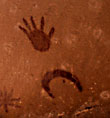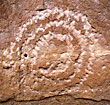|
|
|||||||||||||||||||||||||||||||||

|
|||||||||||||||||||||||||||||||||
|
|
|||||||||||||||||||||||||||||||||
|
|
|
|
|
|
|
||||||||||||||||||||||||||||
|
|
|||||||||||||||||||||||||||||||||
Make Your Own Petroglyph!
by Robin Marks
The sun dagger used by Chacoans to mark the passing of seasons is what archeologists call a “petroglyph.” A petroglyph is a symbol that has been carved into a rock surface by pecking or scraping with another rock. People in many ancient cultures around the world created rock art, and there are many surviving petroglyphs to be found in the deserts of the American Southwest.
In our modern cultures, we still use lots of symbols to represent ideas some simple, some complex. Here are some common glyphs used in our modern world.
What does each of these symbols stand for? What meanings do they have in your culture? Often we don't realize how complex ordinary ideas in our culture are. There is more behind the meaning of a picture than just the object, event, or person it represents. Imagine that you had to explain the meaning of each of these symbols to a primitive Chacoan. What would you have to tell them about your culture in order to make them understand what the symbols mean? Same Object, Different Symbol There are some human experiences—birth, death, sky, earth—that are so universal, nearly every culture has symbols for them. But the symbols differ from culture to culture. For example, here are a variety of sun symbols from various parts of the world:
How are they alike? How are they different? What can the similarities and differences in the symbols tell us about the similarities and differences in how the cultures experienced the sun?
Petroglyphs at Chaco Canyon
Here are some petroglyphs (#1 is actually a pictograph, which means it is painted onto, rather than carved into the rock) found in the Chaco Canyon area. What do you think they might mean?
You can find out more about some of these images by looking at pages and movies on our Web site: • The Time section features descriptions of images 1, 3, and 4. • Petroglyph 3 appears on the boulder Piedra del Sol. • Petroglyph 2 points the way to a sacred site at Wijiji . • All of these images are related to the sun, the sky, or places to observe them. In our Sun Stories movie, researchers and tribe members describe the importance of the sun to Native American cultures. Make Your Own Petroglyph As you can see, the seasons were very important to Chacoan people. The seasons are still an essential part of life in our modern cultures, though sometimes for different reasons. Think about how the seasons are important to you. In what ways do the seasons affect your life? Draw a "petroglyph" that you think represents something significant about the seasons to you. You can incorporate modern symbols, or devise a completely original "petroglyph."
Show your "petroglyph" to other people and ask what their interpretation of it would be. In a classroom, you could work in pairs or small groups and take turns interpreting each others' symbols.
Other Activities
|
|||||||||||||||||||||||||||||||||















